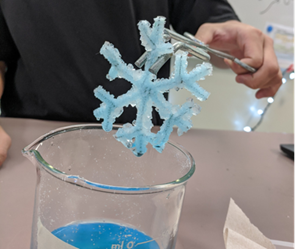
How can we develop chemistry understanding among learners by having them conduct their own chemistry demos?
Chemistry demonstrations provide a great hook into various chemistry topics. They are usually done by the teacher at the beginning of the lesson to spark the learners’ ideas and curiosity. In a Grade 12 Chemistry classroom, learners had the opportunity to find out about the basics of laboratory safety protocols by choosing an area of interest and conducting their own laboratory experiments in their Grade 12 class.
To deepen learners’ ownership of their learning and to give them practical experience, they were tasked with researching, preparing, and presenting a 15-to-20-minute chemistry demonstration to the class, similar to a “science show.” To introduce the concept, learners were first shown sample demonstrations, either live or via videos, to help them understand what a chemistry demonstration entails. They were then provided with resources, including textbooks (e.g., The Golden Book of Chemistry by Robert Brent) and online sources, to select a demonstration that they would perform in front of their peers. In addition to the experiment, learners were asked to consider their audience and develop a back story like a science show to draw the audience to the scientific concept. Lastly, they were required to include the Material Safety Data Sheets (MSDS) for the chemicals used to illustrate the safe handling of each chemical, as this was an authentic step in handling chemicals.
To ensure the safety of each demonstration, each learner met with the teacher to vet their ideas to ensure they were safe and feasible for the classroom. They reviewed the necessary chemicals as to their specific concentration and amount, and reviewed safety protocols so they could practise their experiments prior to their demonstration. They were encouraged to evaluate with their teacher the safety and preparation requirements for and feasibility of using the chemicals.
Before the presentation, each learner reviewed their back story and a peer acted as their practice audience. Using feedback criteria developed by the class, the practice audience gave concrete feedback to improve the presentations and demonstrations. Finally, learners met one on one with the teacher to review the chemicals one last time so that, on the day of their presentation, they were well prepared with their chemicals and had run through the experiment to know what to expect. Sometimes the experiment did not work as expected—this situation is part of chemistry—but the learners understood that the better their preparation, the higher the likelihood of success. Each learner provided their back story, conducted their experiment, and then explained the chemistry of their demonstration to the rest of the class.
By designing their own experiences, learners gained a deeper understanding of the science concepts and the nature of experimentation in science.
*These descriptors represent the dimensions of global competencies in science.
Brent, Robert. The Golden Book of Chemistry Experiments: How to Set up a Home Laboratory—Over 200 Simple Experiments. Illustrated by Harry Lazarus, Golden Press, 1960.